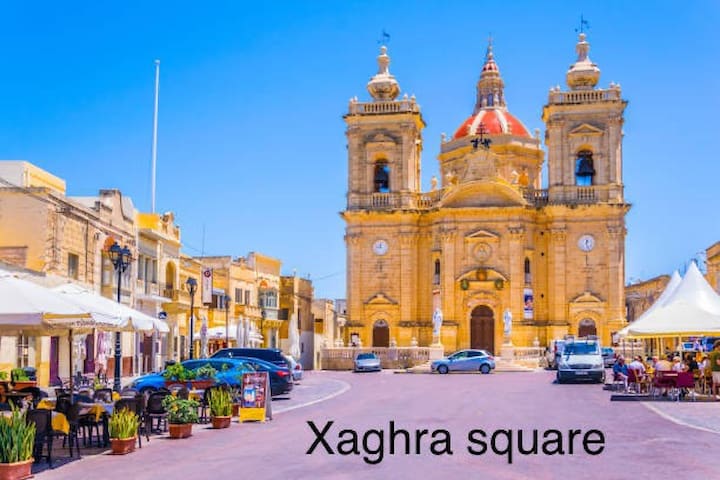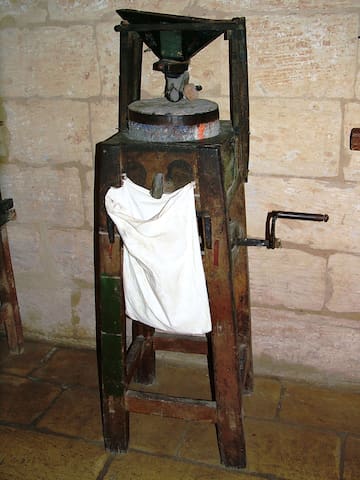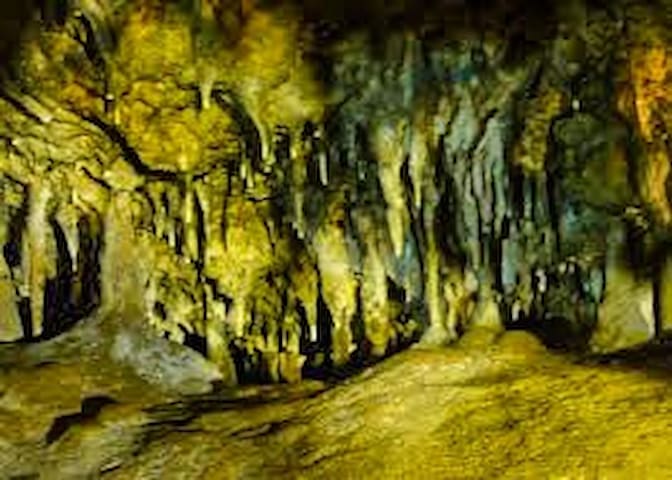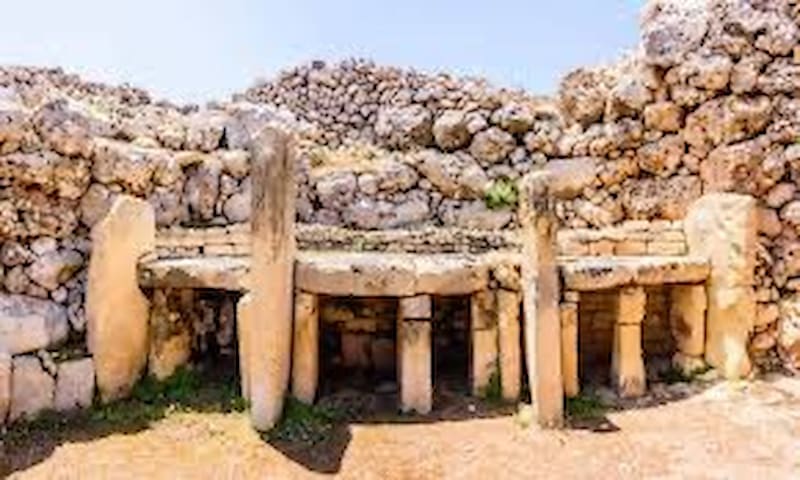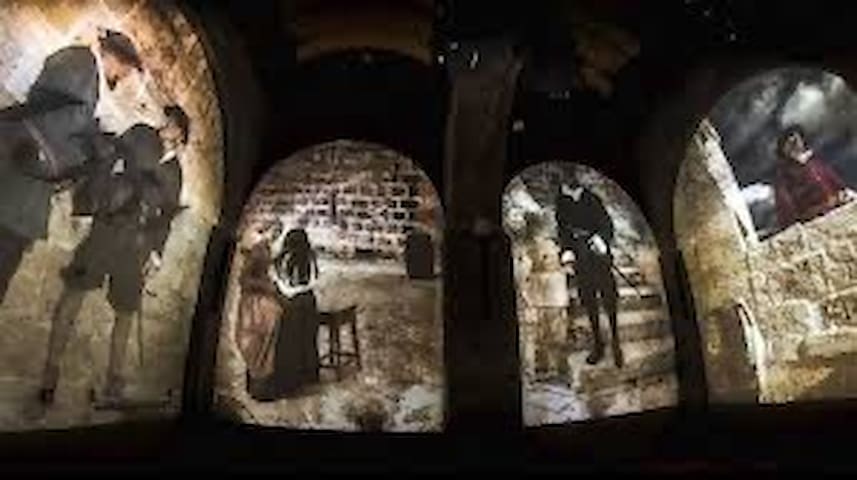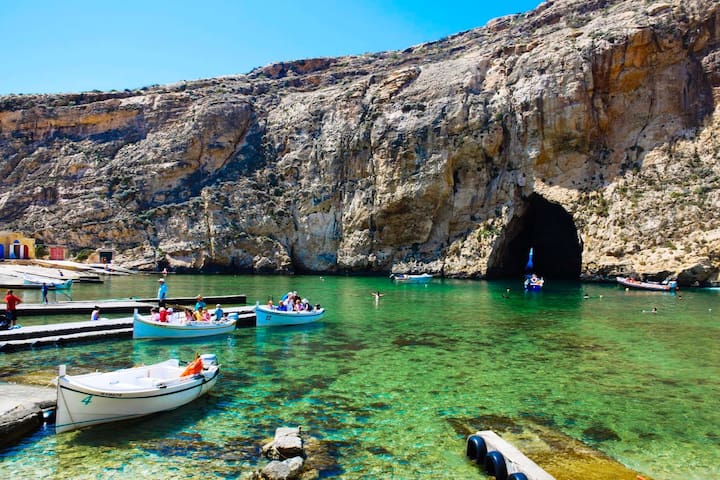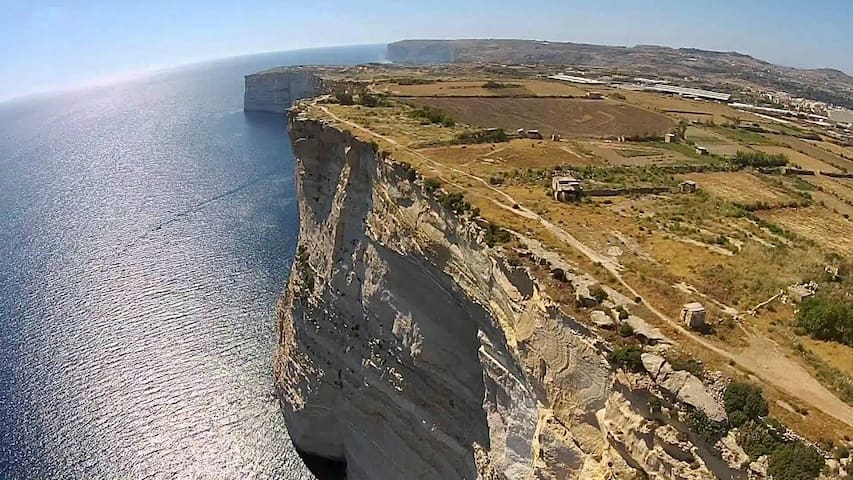Historical places
Xaghra is regarded by most as the crib of ancient civilizations and the home to one of the world’s oldest free standing monuments. The Ggantija Temples are a UNESCO World Heritage site dating back to 3600 years B.C. which makes them older than Stonehenge and the Great Pyramids of Giza. The temples are within 5min walk from the property.
Ġgantija
Triq John Otto BayerThe neolithic site of Sta. Verna and the famous Calypso Cave are both within the ambit of Xaghra. The present village has a more recent history. It was created as a parish in 1688. At the time, the parishioners had to content themselves with a small church and it was only during the last century that they could afford to build a new one. The new church dedicated to the Nativity of the Virgin, was completed in 1855. The church is among one of the most beautiful of the Gozo churches. It stands in a spacious rectangular square, in which one can still see the columnar parish cross and admire the old houses and shops around the perimeter whilst enjoying a traditional meal or an ice cream in one of the restaurants and cafes located around the square. The square is a 10min walk from the property where there are also bus stops with regular public transport linking the village to other parts of Gozo. The church interior is richly decorated with gilt sculptures, stained glass windows, fine Italian marbles and paintings by foremost Maltese artists. The Statue of il-Bambina, representing the Nativity of the Virgin, on it’s silver pedestal is a big attraction to visitors. The statue is carried in procession in the village streets on the feast day, the 8th September, which day is also Victory Day, a National Day in the Maltese Islands.
9 lokale anbefaler
Xaghra Parish Church
Triq Il KnisjaThe neolithic site of Sta. Verna and the famous Calypso Cave are both within the ambit of Xaghra. The present village has a more recent history. It was created as a parish in 1688. At the time, the parishioners had to content themselves with a small church and it was only during the last century that they could afford to build a new one. The new church dedicated to the Nativity of the Virgin, was completed in 1855. The church is among one of the most beautiful of the Gozo churches. It stands in a spacious rectangular square, in which one can still see the columnar parish cross and admire the old houses and shops around the perimeter whilst enjoying a traditional meal or an ice cream in one of the restaurants and cafes located around the square. The square is a 10min walk from the property where there are also bus stops with regular public transport linking the village to other parts of Gozo. The church interior is richly decorated with gilt sculptures, stained glass windows, fine Italian marbles and paintings by foremost Maltese artists. The Statue of il-Bambina, representing the Nativity of the Virgin, on it’s silver pedestal is a big attraction to visitors. The statue is carried in procession in the village streets on the feast day, the 8th September, which day is also Victory Day, a National Day in the Maltese Islands.
Ta’ Kola Windmill in ix-Xagħra, Gozo, is one of the few surviving windmills on the Maltese Islands dating back to the Knights’ Period. Its origins go back to 1725 but it seems to have been built of poor quality stone and mortar and had to be reconstructed in the 1780s. The windmill’s name Ta’ Kola comes from the last miller, who was popularly known as Żeppu ta’ Kola (Joseph, son of Nikola).
When the wind was right for the mill to operate, the miller would blow through a triton-shell (Maltese bronja) to let everynoe know and villagers would bring their grain to be ground into flour. The heavy millstones can still be seen at the top of the mill linked to the central milling mechanism, around which, are the rooms where the miller lived and worked.
On the ground floor is the workshop with a vast array of historic tools, some of which were manufactured by the owners of the mill. On the first floor, the living quarters of the miller and his family, have been recreated using traditional furniture and Gozitan crafts. You can visit the miller’s dining room, bedrooms, and kitchen which is equipped with traditional utensils and cooking ware rarely seen today.
The Kola Windmill is 6 min by walk from the property
20 lokale anbefaler
Ta' Kola Windmill
Il BambinaTa’ Kola Windmill in ix-Xagħra, Gozo, is one of the few surviving windmills on the Maltese Islands dating back to the Knights’ Period. Its origins go back to 1725 but it seems to have been built of poor quality stone and mortar and had to be reconstructed in the 1780s. The windmill’s name Ta’ Kola comes from the last miller, who was popularly known as Żeppu ta’ Kola (Joseph, son of Nikola).
When the wind was right for the mill to operate, the miller would blow through a triton-shell (Maltese bronja) to let everynoe know and villagers would bring their grain to be ground into flour. The heavy millstones can still be seen at the top of the mill linked to the central milling mechanism, around which, are the rooms where the miller lived and worked.
On the ground floor is the workshop with a vast array of historic tools, some of which were manufactured by the owners of the mill. On the first floor, the living quarters of the miller and his family, have been recreated using traditional furniture and Gozitan crafts. You can visit the miller’s dining room, bedrooms, and kitchen which is equipped with traditional utensils and cooking ware rarely seen today.
The Kola Windmill is 6 min by walk from the property
Hidden beneath an ordinary home in a street that bears the cave’s name in ix-Xagħra, is a small cavern with stalactites and stalagmites. The cave was discovered in 1924 by the current owners’ grandfather while he was digging a well. It is illuminated by electric lights so that visitors can see the rock formations.
Entry is via a 10m spiral staircase, built into the original well shaft (so not sutable for anyone with vertigo, mobility problems or a large girth). In the cave you take a circular tour of about 30m past some very pretty calcified formations 25 cm to a metre tall. There are also some interesting formations, which have developed as a result of calcification of tree roots. The visitor will be shown speleothems (stalactites/stalagmites) resembling a tortoise, a vulture, a giraffe and a pair of elephant’s ears. The cave was extended during the Second World War when the family used the cave as an air raid shelter.
Xerri’s grotto is 12 min walk from the property
39 lokale anbefaler
Xerri's Grotto
Hidden beneath an ordinary home in a street that bears the cave’s name in ix-Xagħra, is a small cavern with stalactites and stalagmites. The cave was discovered in 1924 by the current owners’ grandfather while he was digging a well. It is illuminated by electric lights so that visitors can see the rock formations.
Entry is via a 10m spiral staircase, built into the original well shaft (so not sutable for anyone with vertigo, mobility problems or a large girth). In the cave you take a circular tour of about 30m past some very pretty calcified formations 25 cm to a metre tall. There are also some interesting formations, which have developed as a result of calcification of tree roots. The visitor will be shown speleothems (stalactites/stalagmites) resembling a tortoise, a vulture, a giraffe and a pair of elephant’s ears. The cave was extended during the Second World War when the family used the cave as an air raid shelter.
Xerri’s grotto is 12 min walk from the property
To the rear of an ordinary house at No 15 January Street, ix-Xagħra is this natural cave discovered in 1888 by local resident Joseph Rapa. The cave, now well illuminated by electric lights, is remarkable for its plethora of natural stalactites and stalagmites.
The cave is entered via a 4m descent down a flight of steps, which ends in a large chamber approximately 20 m by 8m. The calcification of water dripping from the cave ceiling has formed a forest of magnificent columns. There are even a few helictites (curved stalectites). Most of the formations are now dry and the same colour as the surrounding rock but some remain semitransparent and it is possible to see the rings formed as they grew.
36 lokale anbefaler
Ninu's Cave
Triq JannarTo the rear of an ordinary house at No 15 January Street, ix-Xagħra is this natural cave discovered in 1888 by local resident Joseph Rapa. The cave, now well illuminated by electric lights, is remarkable for its plethora of natural stalactites and stalagmites.
The cave is entered via a 4m descent down a flight of steps, which ends in a large chamber approximately 20 m by 8m. The calcification of water dripping from the cave ceiling has formed a forest of magnificent columns. There are even a few helictites (curved stalectites). Most of the formations are now dry and the same colour as the surrounding rock but some remain semitransparent and it is possible to see the rings formed as they grew.
This small privately owned museum in ix-Xagħra was originally set up by Susan and Edwin Lowe in Devon, England in the 1970’s. It started with one doll and today boasts toys from all over the world. The name Pomzkizillious comes from the artist and writer of nonsense-verse Edward Lear. He made up the word in 1866 to describe the coastal scenery of Gozo which he loved to walk through and to paint on his visit to the island in March 1866. He was in Gozo for one week. According to his Diary he walked 20 miles a day on the island.
The oldest objects on display are a late 18th century Maltese Doll with carved wooden head and some Italian Presepio (nativity scene) figurines dating from the 1790’s. Among other attractions there is a 1930’s Noah’s Ark, a “Hornby” Train Set and Edwin’s “Dinky” vehicles, a pressed paper “Hunting Scene” and “Zoo” which have survived over 100 years, as well as a set of soldiers made in the 1970’s but dressed in the uniform of the Swedish Army in the 1750’s. Also on display is a rare set of unmarked Lead Cricketers and other lead toys including a zoo and farm animals, Cowboys & Indians, Aeroplanes, Ships & Soldiers and an Ambulance Set about 1890’s, along with optical toys, soft toys made by Steiff, Lenci and Kathe Kruse, and a few (Schuco & Lehmann) clockwork tin toys from the 1920/30’s.
The Museum is 4 mins walk from the property
10 lokale anbefaler
The Museum of Toys
Triq Gnien XiblaThis small privately owned museum in ix-Xagħra was originally set up by Susan and Edwin Lowe in Devon, England in the 1970’s. It started with one doll and today boasts toys from all over the world. The name Pomzkizillious comes from the artist and writer of nonsense-verse Edward Lear. He made up the word in 1866 to describe the coastal scenery of Gozo which he loved to walk through and to paint on his visit to the island in March 1866. He was in Gozo for one week. According to his Diary he walked 20 miles a day on the island.
The oldest objects on display are a late 18th century Maltese Doll with carved wooden head and some Italian Presepio (nativity scene) figurines dating from the 1790’s. Among other attractions there is a 1930’s Noah’s Ark, a “Hornby” Train Set and Edwin’s “Dinky” vehicles, a pressed paper “Hunting Scene” and “Zoo” which have survived over 100 years, as well as a set of soldiers made in the 1970’s but dressed in the uniform of the Swedish Army in the 1750’s. Also on display is a rare set of unmarked Lead Cricketers and other lead toys including a zoo and farm animals, Cowboys & Indians, Aeroplanes, Ships & Soldiers and an Ambulance Set about 1890’s, along with optical toys, soft toys made by Steiff, Lenci and Kathe Kruse, and a few (Schuco & Lehmann) clockwork tin toys from the 1920/30’s.
The Museum is 4 mins walk from the property
The ix-Xagħra Stone Circle (not in fact a stone circle) is a prehistoric underground burial site in the village of Ix-Xagħra, 400m from the Ġgantija Temples. The earliest burials took place here around 4000 BC, but it was most extensively used in the last phase of the Temple Period (the Tarxien phase) between 3000 and 2500 BC. The wealth of human remains together with impressive stone and clay sculptures have shed important light on both Maltese prehistory and that of the Mediterranean. Most of the finds – including some delightful human figures – can now be seen in the Gozo
The stone circle is 7 min walk from the property
9 lokale anbefaler
Xagħra Stone Circle
V Caruana SpiteriThe ix-Xagħra Stone Circle (not in fact a stone circle) is a prehistoric underground burial site in the village of Ix-Xagħra, 400m from the Ġgantija Temples. The earliest burials took place here around 4000 BC, but it was most extensively used in the last phase of the Temple Period (the Tarxien phase) between 3000 and 2500 BC. The wealth of human remains together with impressive stone and clay sculptures have shed important light on both Maltese prehistory and that of the Mediterranean. Most of the finds – including some delightful human figures – can now be seen in the Gozo
The stone circle is 7 min walk from the property
Sightseeing
Victoria and the Citadella
Ta Pinu Basilicata
Marsalforn Salt Pans
Ramla bay, Dwejra and Wied il-Mielah
Ta Cenc Cliffs
Citadel
It-Telgħa tal-BeltBażilika-Santwarju Nazzjonali tal-Madonna Ta' Pinu
RoadSalt Pans
Ramla Bay Watersports
Dwejra Bay
Wied Il-Mielaħ
Ta' Ċenċ Cliffs
Take a day trip to the beautiful island of Comino with one of the most beautiful beach Blue Lagoon
179 lokale anbefaler
Comino
Take a day trip to the beautiful island of Comino with one of the most beautiful beach Blue Lagoon
Råd om byen
Sådan kommer du omkring
Activities
Diving and snorkeling, Quad Bikes, Hiking, Boat trips to Blue Lagoon Comino, Catamaran boat trips, Sailing boat trips or self drive boat rentals for more privacy. Visit Gozo by bus, Jeep tour, Buggies, Scooter tour or hire a Tuktuk for the day. Restaurants and bars.


